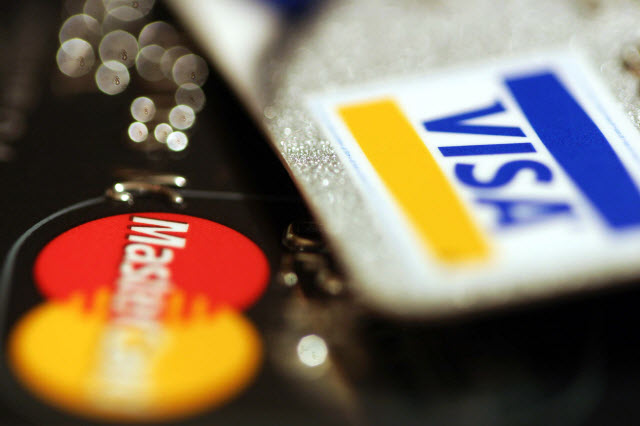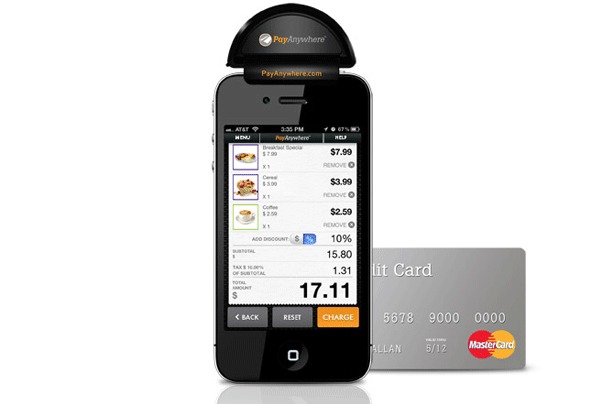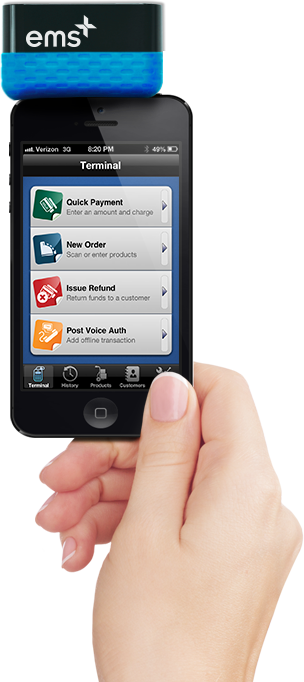5 Ways to Accept Credit Cards in Person

I know that we primarily work with clients who do business online here as opposed to offline businesses. That’s why I’m not going to discuss merchant accounts with traditional credit card swipe machines. However, there are times when you do happen to need to be able to accept a credit card in person as opposed to merely using PayPal.
Sometimes, a client may come to visit you in person and want to pay via credit card. Other times, you may actually be dealing with a local business and you happened to visit them. Whatever the reason may be, it’s always useful to have an option available for accepting credit cards in person as opposed to just using PayPal or Google Checkout.
Not to mention that there are times when your customers will not want to use those services but will be fine with entering their credit card information into your secure server. My own mother for example doesn’t trust PayPal and refuses to use the service even though I’ve tried dozens of times to explain how to use it.
All this is also to say nothing of the fact that PayPal and to a lesser extent some of the other processing services can easily dump you as a customer or simply freeze your account whenever they want to and leave you in limbo for days, weeks or even months.
Why Not a Merchant Account?
Used to be, if you wanted to accept credit cards, you needed to get a merchant account. These accounts were provided to small and large businesses alike by a number of different companies which provided clearing services for people to use credit cards at their place of business. However, if you ran a mail order business or an online business as little as 5 years ago, it was notoriously difficult to get such an account.
Most of the banks who run such services don’t want to deal with online only businesses, especially small ones because they worry that the risk of fraud is much higher. Plus, in order to use a merchant account, you need to spend several hundred dollars for one of those credit card reader machines and often pay a monthly fee to maintain an account. That’s great if you accept credit cards constantly but if you only need to accept a credit card once every few weeks, you need an alternative.
One catch with all of these options though is that they require a smartphone. In most cases, only iOS or Android are supported. I did however find at least one option for Windows Phone and Windows 8 tablet owners as well as one for Blackberry owners, both of which I’ll discuss shortly.
Square
The granddaddy of the new options is of course Square. It’s named as such because they would provide you with a small, square piece of plastic which would attach to your smartphone’s headphone jack and which would then transmit the credit card number to them. You simply swipe the card through the reader and then it would use your cell phone to transmit the information.

The reader turns the information from the swipe into audio which is then picked up your phone’s microphone. Square then transmits the information to their processing center and you get your money the next day, deposited to your bank account.
Square used to offer an unlimited option for small business doing up to $21,000 per month in business but they did away with that and now charge a flat 2.75% of every transaction. Great for those doing very occasional business but a bummer for those who were using it for a larger business. The reader itself is just a small piece of plastic which I’ve heard does tend to feel kind of flimsy though.
If for some reason you need to manually key in the credit information, the price rises to 3.5% plus 15 cents per transaction. The good news is that there are no monthly fees involved and you get the basic reader for free. They also have a kind of platform for iPads which does cost $99 if you want to go that way.
Square only supports Android or iOS devices so those using Blackberry or Windows Phone (or for that matter, Windows 8 on a tablet) are out of luck. Finding out if your Android device is supported by Square is a little confusing. They only list four devices that they know support it but they also say that it’s not limited just to those devices.
That said, they provide some basic guidelines and say that a “normal” or “large” screen size will work as long as you also have a 3.5mm headphone jack, a microphone, Android 2.3 or better (though not Honeycomb or “modified Android devices” whatever that means) location service and access to the Google Play Store.
However, since the device is free, it’s worth ordering one and seeing if it works with your phone. If it doesn’t, it didn’t cost you anything but a few minutes of your time.
PayAnywhere
The PayAnywhere device works in basically the same way as the Square device but with two very important differences. First and foremost, it’s a little more substantial looking meaning that it’s more likely to stand up to repeated use. The Square looks like it could break any second (of course, they designed it to look cool and portable but I prefer something with more heft which I know won’t break when I need it).
The service is also a bit cheaper than Square, taking a flat 2.69% of your transaction but as near as I can tell, there is no option to manually key in information as there is with the Square. However, those with Blackberry devices will definitely want to grab this device since they do happen to support a number of them.

The list of supported Android devices was a bit skimpy though. Basically, if your device isn’t made by Google or Samsung, you need to look elsewhere. They do claim they have plans to support additional Android devices in the future though so it’s worth checking back to see if they’ve added your device since this was written.
PayPal
Huh? Didn’t I mention earlier that these things don’t require your customers to use PayPal to send you money? I did indeed. However, PayPal has decided to get into the same business that Square and others are in with their own card reader. The PayPal Here reader offers the option to swipe a card and have the money deposited directly into your PayPal account.
Like most other devices reviewed here, PayPal offers only to support iOS or Android devices. PayPal says on their website that you should try to download the PayPal Here app on your Android device to see if it works before you order the reader though. Actually, you can’t do anything but that since they require you to use the app to order a reader.
PayPal Here is also a bit cheaper than Square, offering to accept payments at 2.7% instead of the 2.75% Square charges. However, the thing that I think is really cool is something they mention in passing but which I can find very little information about. PayPal Here can, at least in theory also accept paper checks.
From what I understand from third party sources, check acceptance uses your phone’s built in camera to take a picture of the check and then process it that way. Of course, unlike credit cards, you don’t really get the guarantee of payment since a check can bounce. And for the under 30 crowd wondering what a paper check is, ask your parents to explain it to you. It’s just possible you’ll need to know how to write one someday.
Another feature that PayPal Here offers is the ability to pay with – wait for it – a PayPal account. This actually is a nice extra because if your customer shows up without cash, credit card or checks (okay, then we’re getting a little suspicious of them but whatever), they can simply pay with their PayPal account right there on your smartphone through the app.
EMS
There are actually probably at least a dozen different places that offer these kinds of services so I don’t want to cover every single possible option here. However, EMS definitely deserves a mention here and should be one of the places you look at first for your in person credit card processing needs. Why? The answer is simple really – pricing!
EMS, like all the rest will ship you out a free card reader which plugs into your cell phone’s head phone jack. Like most of the rest of these services, they’ll let you accept Visa, MC and Amex (though the fees for Amex are higher). However, the nice thing about EMS is that they charge a lot less than everyone else. They take just 2.25% of your transaction for Visa/MC charges.
EMS says that American Express cards cost more to process because the fees are set directly by Amex and the cost ranges from 2.5% to 3.9% depending on the type of American Express card that you are swiping. They also let you choose which color you want your credit card reader to be.
Innerfence
Last on my list is the Innerfence Card Reader. Like all the other options mentioned here, this one plugs into your smartphone’s headphone jack and allows you to use it to swipe credit cards in person and accept payments that way from your customers. Like all the others on this list, they guys will also offer to let you accept all the major credit cards.
However, there are two very important differences which set apart Innerfence and earn them a place on this list. First and foremost is their pricing scheme, which is a little difficult to follow but could be worthwhile for some people.
They charge a $25 monthly service fee (this is the only service is the roundup that does this). However, for that $25 fee, you get a range of pricing for your swipes. The lowest cost swipes will run you just 1.74% while the highest cost will run you 3.79%. How exactly you’d know what kind of price you’ll pay I’m not really clear on.
Innerfence explains that they have three “tiers” for cards, qualified, mid-qualified and non-qualified. They say that American consumer or debit cards “typically” get the qualified rate, which means the majority of your transactions will be priced at the lower fee. However, some other cards, such as corporate cards and international cards will run at the higher fee.
In addition to the swipe fees, they also charge something called an “assessment fee” which ranges from 0.105% to 0.13% based on your monthly receipts.
These prices might make sense for those who need higher volume card processing since it could end up being cheaper than any of the other options, which charge a higher percentage of your sales but no monthly fees or anything of that nature.
However, there is also one group for whom this service is essential. This is the only device I found that supports Windows Phone and Windows 8 tablet devices. Apparently, they even offer some limited support for those using a Mac but it’s not as simple to use as on other devices. Of course, iOS and Android are supported by these guys as well.
Not that as of this writing, it says the device is free but it seems to have put a time limit on this. I have no idea whether or not this means that they’ll start charging later on though.
My Recommendation
If your device is supported by them, I’d go with a combination of the EMS and the PayAnywhere devices. EMS’ fees are the lowest overall (unless you do a lot of volume in which case, you may want to see if the Innerfence reader is a better choice) but since they charge more for Amex purchases, I’d have the PayAnywhere device for those kinds of cards.
It would also be helpful to have the PayPal Here device and software only for the rare occasions when someone wants to pay with a paper check or with PayPal.
Regardless of which kind of device you ultimately go with, be sure to read all the fine print. Each of these services has its ups and downs so it’s worth looking at all of them very carefully.


